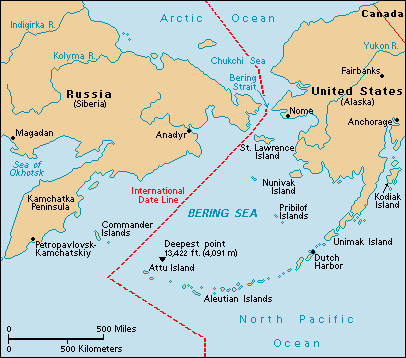Russia and U.S. Agree to Preserve Bering Strait in Natural State
Monday, October 1st, 2012October 1, 2012
The United States and Russia have agreed to preserve the Ice Age heritage of Beringia, an area that includes parts of northeastern Asia and northwestern North America and a land bridge that once connected them. During a recent visit to Russia, U.S. Secretary of State Hillary Rodham Clinton agreed with Russian Foreign Minister Sergei Lavrov to establish the Transboundary Area of Shared Beringian Heritage, a specially protected region that includes the Bering Strait and adjacent areas of Siberia and Alaska. Known as Beringia, this area is home to Inuit and Yuit peoples, who have a common language and traditions but are separated by international borders. A wide range of animals, including polar bears, whales, seals, and walruses, also live there.
At the Bering Strait in the northern Pacific Ocean, the United States and Russia are separated by about 50 miles (80 kilometers) of open water. But during the most recent ice age, huge glaciers covered much of the northern half of Earth and sea level was much lower than it is today. As a result, much of the Bering Strait was a vast stretch of dry land forming a bridge about 1,000 miles (1,600 kilometers) wide at its greatest extent that connected what are now Siberia and Alaska. Most scientists think the first American Indians, following the animals that they hunted, wandered across this harsh environment into North America at least 15,000 years ago. By 12,500 years ago, Indians had spread throughout the New World and were living from the Arctic in the north all the way to what became known as the Strait of Magellan in southern South America.

The Bering Stait is a narrow waterway that connects the Bering and Chukchi seas. (World Book map)
The Transboundary Area of Shared Beringian Heritage formally recognizes the symbolic links between the people and governments of Asia and North America. The new heritage area will aid conservation efforts in this natural ecosystem and promote international cooperation on scientific research and monitoring the enviroment. The new area will formally link two national parks in Alaska–the Bering Land Bridge Natural Preserve and the Cape Krusenstern National Monument–with the newly designated Beringia National Park in Chukhotka, Russia. The region will cover a total of about 7.2 million acres (2.9 million hectares).
United States President George H. W. Bush and Soviet President Mikhail Gorbachev first announced plans to create a transnational park spanning the Bering Strait in 1990, but progress towards the creation of the park stalled. Many components of this new agreement are still being worked out, but officials hope to have a finalized agreement by the end of 2012.
Additional World Book articles:
- Bering, Vitus
- Paleo-Indians
- Prehistoric people
- Anthropology (1951) (a Back in Time article)
- The First Americans (a Special Report)


